The gate valve is suitable for stopping or opening the fluid flow. Its valve direction of movement is vertical to the direction of fluid flow. It acts as a stop valve. It is not suitable for throttling or adjusting fluid flow. Its symbol is as given below.

This type of valve (also known as a wedge valve or slide valve) is a fully opening and closing device. The valve fully allows or prevents the passage of a fluid.
What is Gate Valve?
The valve has a disc (or a gate). The gate has a transverse motion in the direction of fluid flow. Thus, this arrangement either fully stops or opens the passage of fluid.
Gate valve finds its application where it is necessary to handle a constant flow of liquid and at the same time restrict the flow rate of the flow itself to limited values. The gate valves are suitable for high pressures and temperatures. We can use the gate valves for a wide range of fluids.
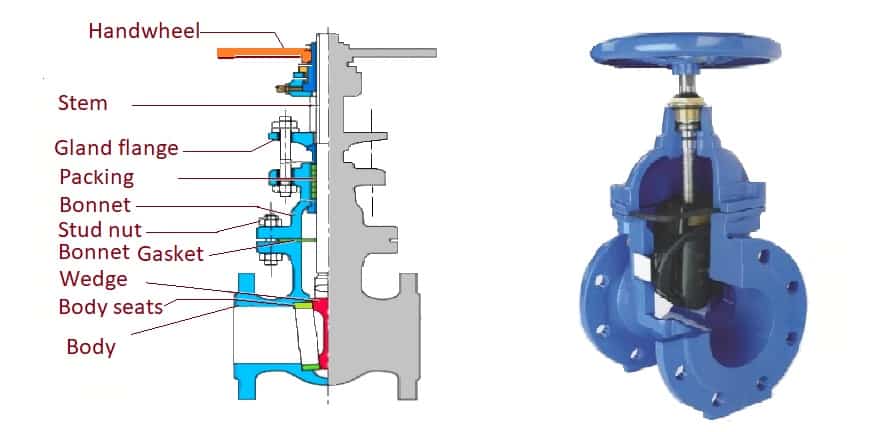
It is a bi-directional valve. The gate is symmetrical at both ends. Therefore, we can use the inlet as an outlet & vice versa. It allows the fluid flow in both directions.
There are various construction forms of gate valves. Some of the constructive forms are.
- Rising Stem
- Falling Stem
- Knife
- Bulkhead
- Expansion
Types of Gate Valves
There are two types of gate valves based on the stem design.
- Rising Stem
- Non-rising Stem
Rising Stem
In the rising stem valve, the stem rises out on the opening of the valve. We can judge the valve opening or closing from the appearance of the valve stem. The valve stem nut is in the valve bonnet or housing when the valve is fully closed. The stem rotates to lift (gate open) and lower (gate close).
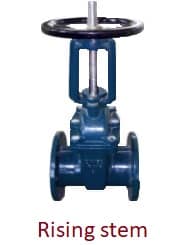
This type of design is very popular because it is easy to lubricate the valve stem lead screw.
Non-Rising Stem
Non-rising stem means external stem. We also call it a rotational stem design gate valve. The stem rotates to open and close the gate but, the stem does not move up or down as it rotates.
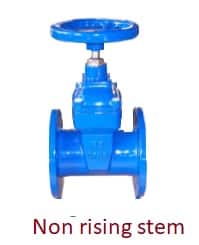
Upon operating, the stem rotates, and the gate moves in or out. In this way, the non-rising stem moves the gate to open or seal the valve.
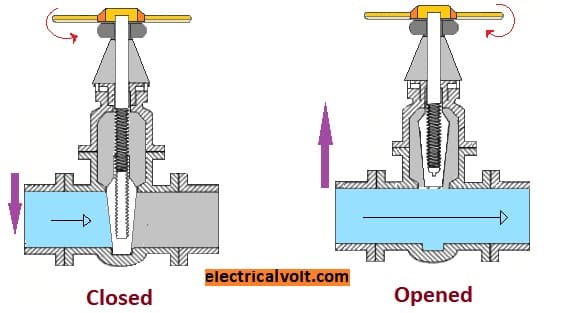
Non-rising stem valve takes up less space. Therefore, it is most suitable where space is a constraint. The advantage of the non-rising pattern is that the height of the valve does not change. The total height remains the same, so a small control unit can be installed.
It is suitable for large diameter valves with limited space for the control unit.
The disadvantage of a non-rising stem valve is that it is impossible to lubricate the valve stem lead screw. Also, the valve stem is in direct contact with the medium. As a result, it can cause erosion and damage to the valve.
There are two types based on the gate configuration:
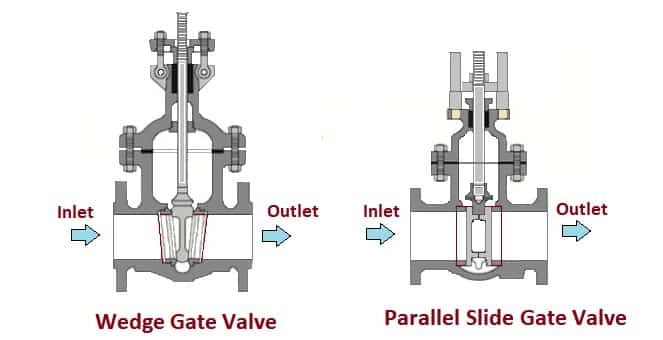
Parallel Slide Gate Valve
Parallel slide gate valves can be divided into a single and a double gate. In parallel slide construction, as shown in the above figure, the sealing surface is parallel to the vertical centerline. It has an upper and bottom sealing parallel to each other.
Wedge Gate Valve
It has a wedge-type construction. It has an up and down gate operation for opening and closing.
The wedge gate valve can be classified into single, double & flexible gate types. The sealing surface of the gate valve forms an angle with the vertical centerline. Here, the two sealing surfaces form the shape of a wedge.
Material of construction
Carbon steel, stainless steel, Monel, Duplex, Inconel.
Advantages
- High capacity.
- A very efficient hermetic closure.
- They are cheap.
- A very simple operation.
- They are a little resistant to movement.
Disadvantages
- They are not efficient in controlling the flow.
- Produce cavitation with low-pressure drop.
- Must be fully open or closed.
- Not to be used for throttling purposes.
Applications
The most common application is for water pipelines, especially cold water.
Read Next: